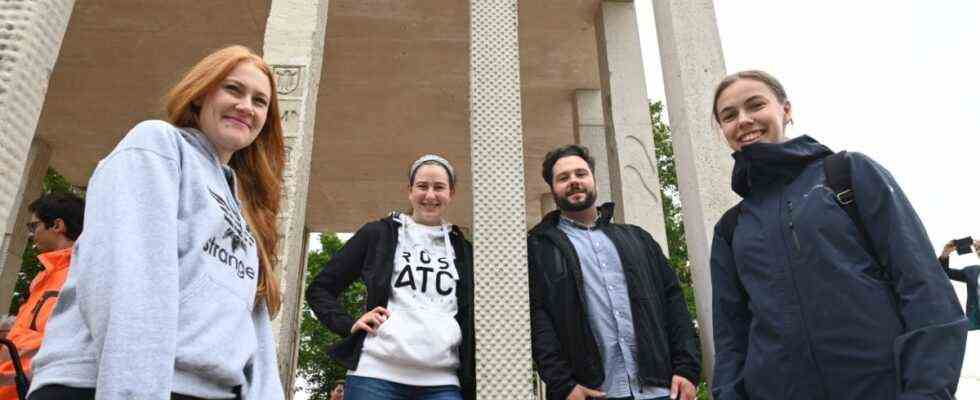For her, the most beautiful support is the one with the studs, says Magdalena Gernhäuser: These studs point outwards on one side of the pillar, on the other they protrude as indentations inwards, just as if someone had pushed them through the concrete pressed. Unplastered concrete is frowned upon for optical reasons, says the 22-year-old. But the pillars would show that concrete can also be beautiful.
Magdalena Gernhäuser is studying architecture at the Munich University of Applied Sciences, but on Thursday morning she was standing in the drizzle on the site of the former Bayern barracks in Freimann. About 40 students have built a pavilion here, 20 square meters in size. They made pillars and a ceiling and erected the components. Now you have presented the finished building. They call it a prototype. Because it should not only show that you can also build aesthetically with unplastered concrete. It also has a second special feature that is less noticeable: the components are made of concrete that is recycled on site. 100 percent.
The pillars show that concrete can also be beautiful.
(Photo: Catherina Hess)
On the former barracks site on Heidemannstrasse, the city is breaking new ground in building, together with the Free State, associations and companies. Apartments for up to 15,000 people are to be built here over the next few years – and the rubble that arises from the demolition of the barracks is to be recycled on site. 200,000 tons of recycled concrete are to be obtained. The building material could be “the key to climate neutrality in the building sector,” said local government officer Kristina Frank on Thursday. Concrete recycling makes ecological and economic sense and there is no alternative in the long term. With property developers, however, the material meets with reservations; hence this prototype. The foundation stone was laid in May. Developers can now view the finished building. It is not open to the public – it is on a construction site.
The pavilion is designed as a model building for five years.
(Photo: Catherina Hess)
The building is a bit like a cage. Four of the 20 pillars are load-bearing, the others show what is possible in terms of design: everyone is special. One of them has knobs – to do this, they would have installed dimpled sheets, which are always left over on construction sites, in the cladding, says Gernhäuser. One support shows footprints from the soles of a shoe, another has the profile of a car tire, another the prints of jeans. Another support looks like a sofa – and with a little imagination it even feels like it. To do this, students mounted plastic-covered egg boxes in the casings.
The building material convinced the participating professors at the university. Arthur Wolfrum, professor of architecture, says he might not use recycled concrete for highly stressed parts such as bridges, but otherwise it is a “real alternative”. Andrea Kustermann, professor of civil engineering, says the only problem is the resistance of the recycled concrete to frost and de-icing salt, because of smaller inclusions. But that is less of a static problem.
Kustermann wants to develop the technology further. And Frank wants to present further ideas to the city council in 2021 on how to put more emphasis on a circular economy in building. The municipal housing company GWG wants to be the first developer to build with recycled concrete on the grounds of the Bayernkaserne, said Frank.
And the pavilion? As a model building, it is initially designed for five years, says Wolfrum. But who knows: maybe the residents will like it later when the site is built on. Static he could also stay longer.

